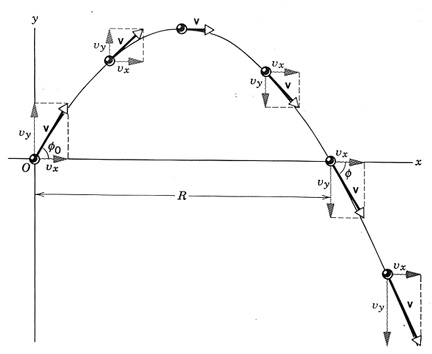Projectile:
A particle thrown up with some angle of elevation with initial velocity vo shall traverse a path called trajectory, and the motion is called projectile as illustrated in Figure

The equation of this motion may be written as under :
x = v0 cos θ t
y = v0 sin θ t - 1/2 gt 2
where, g = gravitational acceleration.
Removing t from the above equations
t = x / vo cos θ
y = x tan θ - g x2 / 2 v 2 cos2 θ
Thus , It may be shown that the traced (trajectory) is a parabola. The velocity along x axis is constant and is equal to
vx = vo cos θ
and x = distance travelled along x axis
= vo (cos θ) t
Velocity at any instant along y axis shall be
v y = vo sin θ - gt
and, y = distance travelled along y axis
= vo sin θ t - (1/2) g t 2 (as written above)
H, the maximum height attained by the projectile, shall be attained at the instant when
vy = 0.
∴ 0 = v y = vo sin θ - g t
∴ t = vo sin θ / g = time since t = 0, to obtain maximum height (H).
Hence,
H = vo sin θ × ((vo sin θ) /g) - (½)g vo2 sin2 θ/g2
= v o2 sin 2 θ / 2 g
While the particle crosses x axis again, that means when it is at B, vertical distance travelled is zero. It is called the range of the projectile and normally mention by R.
We have y = vo sin θ t - (½) g t 2 = 0
then
∴ t = 2 vo sin θ / g
R = vo cos θ . t
= v o cos θ × ((2 vo sin θ)/g )= (vo2 sin 2 θ )/g
It gives us,
T = time for projectile = (2 vo sin θ )/g